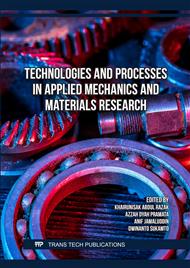[1]
M. Jamari, Sugiyanto, Tauviqirrahman, C. Ansori, and R. Ismail, Analisa Pengaruh Ketebalan Acetabular Cup terhadap tekanan Kontak Pada Sambungan Tulang Pinggul Buatan,Pros. Semin. Nas. Sains dan Teknol., p.86–91, 2010.
Google Scholar
[2]
K. R. Harrysson, O. L., Cormier, D. R., Marcellin-Little, D. J., & Jajal, Direct Fabrication of Metal Orthopedic Implants Using Electron, p.439–446, 2003.
Google Scholar
[3]
N. Qosim, Fabrikasi Prototipe Implan Tulang Maksilofasial sebagai Produk Implan Lokal, vol. 21, no. 4, p.231–236, 2019.
DOI: 10.14710/rotasi.21.4.231-236
Google Scholar
[4]
R. Susanto, B. Yuza, D. A. Hermawan, and A. Fadli, Potensi Pembuatan Replika Tulang Berpori Menggunakan Template Ampas Tebu, Chempublish, vol. 5, no. 2, p.116–129, 2021.
DOI: 10.22437/chp.v5i2.10612
Google Scholar
[5]
P. Kumar, R. Singh, and I. P. S. Ahuja, Investigations on dimensional accuracy of the components prepared by hybrid investment casting, J. Manuf. Process., vol. 20, p.525–533, 2015.
DOI: 10.1016/j.jmapro.2015.07.008
Google Scholar
[6]
R. Dojka, J. Jezierski, and N. S. Tiedje, Geometric Form of Gating System Elements and Its Influence on the Initial Filling Phase, J. Mater. Eng. Perform., vol. 28, no. 7, p.3922–3928, 2019.
DOI: 10.1007/s11665-019-03973-9
Google Scholar
[7]
P. Development and K. Prathan, Optimization of sprue design for advanced investment casting through FEA analysis, 2020.
Google Scholar
[8]
P. N. Rao, Manufacturing technology, vol. 1. Tata McGraw-Hill Education, 2013.
Google Scholar
[9]
R. Thompson, Investment Casting. London, United Kingdom: Thames and Hudson Ltd, 2017.
Google Scholar
[10]
F. Achmad, Simulasi dan Perbaikan Pengecoran Cetakan Pasir Pada Crackshaft Sinjai (Mesin Jawa Timur) Material FCD 600, 2015.
Google Scholar
[11]
D. Schwam, Gating of Permanent Molds for Aluminum Castings. Cleveland, 2004.
Google Scholar
[12]
Y. L. Xiaolin Chen, Finnite Element Modelling and Simulation with ANSYS Workbench, Second edi. CRC Press Taylor & Francis Group, LLC, 2019.
Google Scholar
[13]
L. Yang et al., Numerical simulation and experimental verification of gravity and centrifugal investment casting low pressure turbine blades for high Nb-TiAl alloy, Intermetallics, vol. 66, p.149–155, 2015.
DOI: 10.1016/j.intermet.2015.07.006
Google Scholar
[14]
J. Rafique, M. M. A. & Iqbal, Modeling and simulation of heat transfer phenomena during investment casting, Int. J. Heat Mass Transf., vol. 52, p.2132–2139, 2009.
DOI: 10.1016/j.ijheatmasstransfer.2008.11.007
Google Scholar
[15]
P. . Rao, Manufacturing Technology: Foundry, Forming and Welding, Second Edi. New Delhi: McGraw Hill, 2003.
Google Scholar
[16]
S. Santhi, S. B. Sakri, D. H. Rao, and S. Sundarrajan, Estimation of shrinkage porosity of a cast aluminium alloy," i-manager's J. Mech. Eng., vol. 2, no. 2, p.19–25, 2012.
DOI: 10.26634/jme.2.2.1567
Google Scholar
[17]
B. D. Ratner, Introduction-biomaterials science an envolving multidisciplinary endeavor. Cambridge, MA, USA: Elsevier, Academic Press, 2013.
Google Scholar
[18]
A. R. and M. R. Barkhudarov, Casting: An Analytical Approach. USA: Springer US, 2007.
Google Scholar
[19]
R. F. Beeley, P. R. & Smart, Investment casting. Institute of Materials London, 1995.
Google Scholar
[20]
C. M. Choudhari, B. E. Narkhede, and S. K. Mahajan, Casting Design and Simulation of Cover Plate using AutoCAST-X Software for Defect Minimization with Experimental Validation, MSPRO, vol. 6, no. Icmpc, p.786–797, 2014.
DOI: 10.1016/j.mspro.2014.07.095
Google Scholar
[21]
S. Chastain, Metal Casting: A Sand Casting Manual for the Small Foundry. Jacksonville: Stephen Chastain, 2004.
Google Scholar
[22]
A. Peregrina, B. L. Schorr, and K. City, Comparison of the effects of three sprue designs on the internal porosity in crowns cast with a silver-free high-palladium alloy, vol. 64, no. 1, 1982.
DOI: 10.1016/0022-3913(90)90172-9
Google Scholar
[23]
S. Stein, Porosity and accuracy of multiple-unit titanium castings," no. 6, p.534–541, 1995.
Google Scholar
[24]
R. G. Verrett and E. S. Duke, The effect of sprue attachment design of castability and porosity, vol. 61, p.418–424, 1989.
DOI: 10.1016/0022-3913(89)90006-1
Google Scholar
[25]
R. Compagni, R. R. Faucher, and R. A. Yuodelis, Effects of sprue design, casting machine, and heat source on casting porosity, p.41–45.
DOI: 10.1016/0022-3913(84)90179-3
Google Scholar
[26]
M. et al. Alvarez-Vera, Failure analysis of Co–Cr hip resurfacing prosthesis during solidification, Case Stud. Eng. Fail. Anal., vol. 1, p.1–5, 2013.
DOI: 10.1016/j.csefa.2012.10.002
Google Scholar
[27]
A. Wu, M., Ahmadein, M. & Ludwig, Premature melt solidification during mold filling and its influence on the as-cast structure., Front. Mech. Eng., vol. 13, p.53–65, 2018.
DOI: 10.1007/s11465-017-0437-y
Google Scholar
[28]
S. Yuli, In-vitro Behaviour of Co-Cr-Mo Alloy Prepared by Electrone Beam Melting (EBM) in Inflamantory Artificial Blood Plasma, Tohoku University, 2018.
Google Scholar
[29]
E. Y. Salawu, O. O. Ajayi, A. O. Inegbenebor, O. State, and C. Author, Turbulence Flow Simulation Of Molten Metals In Runners For Defect Control In Casting Of A Spur Gear," vol. 10, no. 01, p.1921–1933, 2019.
Google Scholar
[30]
Volkswagen, Volkswagen Standard VW 50093 'Porosity of Metal Castings, Volkswagen Aktiengesellschaft, 2012.
Google Scholar
[31]
ASM International, Book of materials for medical devicesHandbook of Materials for Medical Devices, ASM Int., 2003.
Google Scholar
[32]
M. Raza, Process development for investment casting of thin-walled components, Sch. Inov. Des. Eng. Malarbalen Univ. Vasteras, 2015.
Google Scholar



